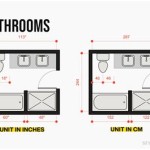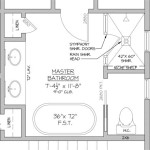Bathroom Toilet Rough-In Dimensions: A Comprehensive Guide
Understanding toilet rough-in dimensions is crucial for successful bathroom remodeling or new construction projects. These measurements dictate the placement of the toilet relative to the wall and are essential for ensuring proper plumbing connections and comfortable use. Ignoring these dimensions can lead to costly rework, plumbing issues, and an awkwardly positioned toilet. This article provides a detailed explanation of toilet rough-in dimensions, covering standard sizes, measurement techniques, common problems, and considerations for various bathroom configurations.
The rough-in dimension refers to the distance from the finished wall (the wall after tiling or paneling) to the center of the toilet's drainpipe, also known as the closet flange. This measurement is not the distance to the wall itself before finishes are applied. Accurate determination of this dimension is vital to prevent the toilet from sitting too close to or too far away from the wall, affecting both aesthetics and functionality.
Standard Toilet Rough-In Sizes
The most common toilet rough-in size is 12 inches. This standard accommodates the majority of toilet models and bathroom layouts. However, variations exist, primarily 10-inch and 14-inch rough-ins. These alternative sizes are often found in older homes or in situations where space is limited or plentiful, respectively. Identifying the correct rough-in dimension before purchasing a toilet is paramount to avoid compatibility issues and the need for costly plumbing modifications.
A 12-inch rough-in allows for sufficient space between the toilet and the wall, providing adequate legroom and ease of cleaning. This size is generally suitable for bathrooms of average dimensions and offers the widest selection of toilet models. However, in smaller bathrooms, a 10-inch rough-in may be necessary to maximize available space. Conversely, in larger bathrooms, a 14-inch rough-in can be used to create a more spacious and luxurious feel.
It is important to note that these dimensions are nominal. Actual measurements can vary slightly, typically by plus or minus a quarter of an inch. This variation is due to manufacturing tolerances and installation practices. Therefore, it is always advisable to measure the actual rough-in dimension after the finished wall is in place to ensure an accurate fit.
Measuring Toilet Rough-In Dimensions
Accurate measurement of the toilet rough-in is crucial for selecting a compatible toilet. The measurement should be taken after the finished wall is complete, including any tiling, paneling, or other surface treatments. This ensures that the measurement reflects the final distance between the wall and the center of the drainpipe.
To measure the rough-in dimension, use a measuring tape and extend it from the finished wall to the center of the closet flange. The closet flange is the round fitting on the floor that connects the toilet to the drainpipe. The center of the flange is typically marked with a circle or crosshair. Align the measuring tape carefully to ensure an accurate reading.
If replacing an existing toilet, the old toilet can be removed to expose the closet flange. Clean any debris or residue around the flange to ensure a clear view and accurate measurement. If installing a new toilet in a new construction or renovation project, the rough plumbing should be completed, including the installation of the closet flange, before taking the measurement.
In cases where the existing rough-in deviates from the standard sizes, there are several options. One option is to use an offset toilet flange. An offset flange allows for some adjustment, typically up to 2 inches, in the position of the toilet relative to the drainpipe. This can be a cost-effective solution for minor discrepancies. Another option is to replace the existing drainpipe and closet flange with a new one that matches the desired rough-in dimension. This is a more involved process but may be necessary for larger discrepancies or when renovating the entire bathroom.
Addressing Common Toilet Rough-In Problems
Various issues can arise related to toilet rough-in dimensions. One common problem is an incorrect rough-in size, either due to errors during the initial plumbing installation or changes in the bathroom layout over time. If the rough-in is too small, the toilet will sit too close to the wall, potentially restricting legroom and making cleaning difficult. Conversely, if the rough-in is too large, the toilet will sit too far away from the wall, creating an unsightly gap and potentially exposing the plumbing connections.
Another potential problem is a misaligned closet flange. If the flange is not properly centered or is not level, it can cause the toilet to rock or wobble. This can lead to leaks, damage to the toilet, and potential structural issues. A misaligned flange can often be corrected by using shims or by replacing the flange entirely.
In older homes, the rough-in dimension may not conform to modern standards. This can be due to changes in plumbing codes or the use of non-standard fixtures. In such cases, it may be necessary to modify the plumbing to accommodate a new toilet. This can involve relocating the drainpipe or using specialized fittings.
When facing rough-in problems, consulting with a qualified plumber is highly recommended. A plumber can assess the situation, identify the underlying cause of the problem, and recommend the most appropriate solution. They can also perform any necessary plumbing modifications safely and efficiently.
Beyond the rough-in dimension, other measurements are relevant to toilet installation. These include the height of the toilet bowl, the width of the toilet, and the distance from the toilet to surrounding fixtures and walls. Standard toilet bowl heights range from 15 to 19 inches. Comfort height toilets, which are typically 17 to 19 inches tall, are becoming increasingly popular due to their ease of use, particularly for elderly or disabled individuals.
The width of the toilet can also vary depending on the model. Elongated toilets, which have an oval-shaped bowl, are typically wider than round-front toilets. The distance from the toilet to surrounding fixtures and walls should comply with local building codes. These codes typically specify minimum clearances to ensure adequate access and safety.
In addition to physical dimensions, consider the location of the water supply line. The water supply line provides water to the toilet tank and should be located within easy reach of the toilet. The standard location for the water supply line is typically on the left side of the toilet, about 6 to 8 inches above the floor. However, some toilets may require a different water supply location, so it is important to check the manufacturer's specifications before installation.
Proper ventilation is another important consideration for toilet installation. Adequate ventilation helps to remove odors and moisture from the bathroom. This can be achieved through the use of an exhaust fan or by ensuring that the bathroom has sufficient natural ventilation.
Finally, consider the overall aesthetic of the bathroom when selecting a toilet. Toilets are available in a wide variety of styles, colors, and finishes. Choose a toilet that complements the overall design of the bathroom and reflects your personal taste. Consider factors such as the shape of the bowl, the style of the tank, and the color of the fixture.

Tiling Around Toilet Plumbing Residential Bathroom

American Standard Cadet Pro Compact Tall Height 14 In Rough 2 Piece 1 28 Gpf Single Flush Elongated Toilet Linen Seat Not Included 215fc104 222 The Home Depot

How To Measure Toilet Rough In Distance Measurement

Toilet Rough In Dimensions Plumbing Residential Bathroom

Toilet Rough Ins And The Cleverness Of S Unifit In

Toilet Rough In The 4 Dimensions You Need To Know Hammerpedia

How To Measure Toilet Rough In Distance Measurement

Bathroom Plumbing Rough In Dimensions Astonishing Toilet Sink Drain

American Standard Cadet Pro Compact Tall Height 14 In Rough 2 Piece 1 6 Gpf Single Flush Elongated Toilet White Seat Not Included Com

Consumers Map Toilet Testing
Related Posts







